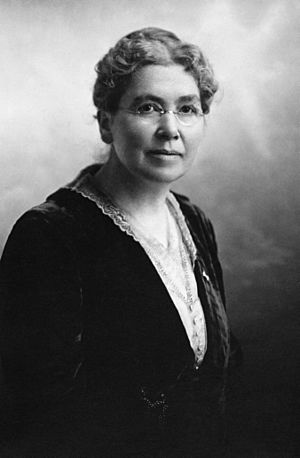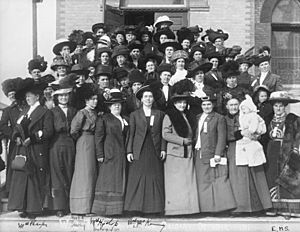Louise McKinney facts for kids
Quick facts for kids
Louise McKinney
|
|
|---|---|

Louise McKinney in 1917
|
|
| Member of the Legislative Assembly of Alberta | |
| In office 7 June 1917 – 18 July 1921 |
|
| Preceded by | William Moffat |
| Succeeded by | Thomas Milnes |
| Constituency | Claresholm |
| Personal details | |
| Born |
Louise Crummy
22 September 1868 Frankville, Ontario, Canada |
| Died | 10 July 1931 (aged 62) Claresholm, Alberta, Canada |
| Political party | Non-Partisan League |
| Other political affiliations |
United Farmers |
| Spouse |
James McKinney
(m. 1896) |
| Children | 1 son |
| Occupation |
|
Louise McKinney (born Crummy; September 22, 1868 – July 10, 1931) was a Canadian politician and a strong supporter of women's rights. She also worked to limit alcohol use.
She made history as the first woman elected to the Legislative Assembly of Alberta. This also made her the first woman to serve in any legislature in the entire British Empire. She was a member of the Non-Partisan League from 1917 to 1921.
Later, Louise McKinney became one of the famous group known as the Famous Five. These women successfully fought for Canadian women to be allowed to become members of the Senate. Before her political career, she was a schoolteacher and helped organize groups that worked against alcohol. She moved to Alberta in 1903 to start a farm.
McKinney was very active in the Woman's Christian Temperance Union (WCTU). She led the Alberta branch of this group for 22 years, from 1908 to 1930. In 1930, she became the president of the WCTU for all of Canada. She also helped organize a big international meeting in Toronto in 1931. In 2009, the Senate of Canada voted to make McKinney and the other Famous Five members Canada's first honorary Senators.
Contents
Early Life and Education
Louise Crummy was born on September 22, 1868, in Frankville, Ontario. She was the sixth of ten children. Her father had moved from Ireland to Canada in 1842.
Louise wanted to become a doctor after finishing high school at Athens High School. However, it was very hard for women to get into medical school back then. Instead, she went to Ottawa Normal School to become a teacher. She taught in Ontario for four years. Then, she moved to North Dakota and taught there for three more years.
Working for the Woman's Christian Temperance Union

While teaching in North Dakota, Louise McKinney became very interested in the Woman's Christian Temperance Union (WCTU). This group worked to reduce or stop the use of alcohol. In 1894, she became a local organizer for the WCTU. She traveled around North Dakota, speaking about the problems caused by alcohol.
During this time, she met James McKinney. They got married in March 1896. They had one son, Williard, who was named after Frances Willard, the founder of the WCTU. In 1898, Louise was elected as the WCTU's District President for her area in North Dakota. She represented her district at the national meeting the next year.
The McKinneys continued farming in North Dakota until 1903. Then, they moved to what is now Alberta, settling near Claresholm.
Within a few weeks of arriving in Alberta, Louise McKinney started a local WCTU group. The next year, she met with women from across the region to form a larger union. This group was first called the Northwest Territories' WCTU. After Alberta and Saskatchewan became provinces in 1905, it was renamed the Alberta and Saskatchewan WCTU. By 1912, the organization had so many members that it split into separate groups for each province.
McKinney was the president of the Alberta WCTU for 22 years, from 1908 to 1930. During the same time, she was also the vice-president of the WCTU for all of Canada. In 1930, she was elected president of the Canadian WCTU. She helped organize the 1931 World Convention in Toronto, where she was also chosen as vice-president of the World WCTU.
Political Career
McKinney decided to run for a seat in the Alberta Legislature. She ran for the Claresholm area in the 1917 general election. This was the very first election where women in Alberta were allowed to vote. She ran as a candidate for the Non-Partisan League. She won the election, defeating the current politician, William Moffat.
By winning, she became the first woman ever elected to a legislature in the entire British Empire. During her time in office, she focused on making laws to control alcohol more strictly. She became known as a very good debater.
Louise McKinney worked with Henrietta Muir Edwards to create a new law. This law made sure that widows would receive a part of their husbands' property after they died. This important law became known as the Dower Act.
McKinney also supported the creation of special institutions. These places would care for people with mental health challenges. She believed this would help prevent certain conditions from being passed on.
She ran for a second term in the 1921 Alberta general election. This time, she was a member of the United Farmers party. However, she lost to an independent candidate named Thomas Milnes by only 46 votes.
Even though she did not run for political office again, she stayed very active. In 1925, she was one of only four women chosen to sign the Basis of Union for the United Church of Canada. She was the only woman from Western Canada to do so.
The Persons Case
Louise McKinney was one of the Famous Five. This group included Irene Parlby, Henrietta Muir Edwards, Emily Murphy, and Nellie McClung. These five women fought for a very important right: to be legally considered "persons" under Canadian law. If they were "persons," they could be appointed to the Senate of Canada.
This legal battle is officially called Edwards v Canada (AG). But it is more commonly known as the Persons Case. In 1927, the case went to the Supreme Court of Canada. The court ruled that women were not eligible to serve in the Senate.
However, in 1929, the Famous Five appealed this decision. They took their case to the Judicial Committee of the Privy Council. This was Canada's highest court at the time. The Judicial Committee overturned the Supreme Court's decision. This meant that women were indeed "persons" and could serve in the Senate. The very next year, Cairine Wilson became the first woman appointed to the Senate.
Death and Recognition
Louise McKinney became ill during the WCTU World Convention in June 1931. Her health got worse after she returned home to Claresholm. She passed away the following month, less than two years after the Famous Five won the Persons Case.
Her death was a big shock to the WCTU. Tributes and messages of sadness came from all over Canada and the world.
In 1939, the Canadian government recognized McKinney as a Person of National Historic Significance. A special plaque honoring her is displayed at the post office in Claresholm. In 1997, the Persons Case itself was recognized as a National Historic Event.
In 2000, two identical monuments were created. One is in Calgary, Alberta, and the other is near the Senate of Canada Building in Ottawa, Ontario. These monuments are called Women are Persons!. They show the members of the Famous Five reading the news about their victory in the Persons Case. These monuments were later featured on the $50 banknote of the Canadian Journey series. In October 2009, the Senate voted to name McKinney and the rest of the Famous Five Canada's first "honorary senators."
Images for kids
See also
 In Spanish: Louise McKinney para niños
In Spanish: Louise McKinney para niños





